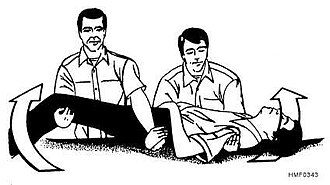Difference between revisions of "AY Honors/First aid/Two person carry/es"
(Created page with "</noinclude> thumb|300px|right|Traslado con dos personas") |
(Created page with "Llevar una víctima manualmente es fatigante para rescatador e implica el riesgo de aumentar la gravedad de las lesiones. En algunos casos, sin embargo, son esenciales para sa...") |
||
| Line 2: | Line 2: | ||
[[Image:Two-person_arm_carry.jpg|thumb|300px|right|Traslado con dos personas]] | [[Image:Two-person_arm_carry.jpg|thumb|300px|right|Traslado con dos personas]] | ||
| − | + | Llevar una víctima manualmente es fatigante para rescatador e implica el riesgo de aumentar la gravedad de las lesiones. En algunos casos, sin embargo, son esenciales para salvar la vida de la víctima. Aunque el traslado manual son realizados por una o dos personas, ltraslados por dos personas se utilizan siempre que sea posible. Proporcionan una mayor comodidad a la víctima, es menos probable que agrave sus lesiones y también son menos agotadores para los rescatadores, permitiéndoles llevar la víctima más lejos. | |
One two-person carry that can be used in emergencies is shown here. Two rescuers position themselves beside the casualty, on the same side, one at the level of the chest and the other at the thighs. The rescuers interlock adjacent arms as shown, while they support the victim at the shoulders and knees. In unison, they lift the victim and roll his front toward theirs. '''This carry must not be used to move seriously injured persons.''' | One two-person carry that can be used in emergencies is shown here. Two rescuers position themselves beside the casualty, on the same side, one at the level of the chest and the other at the thighs. The rescuers interlock adjacent arms as shown, while they support the victim at the shoulders and knees. In unison, they lift the victim and roll his front toward theirs. '''This carry must not be used to move seriously injured persons.''' | ||
Revision as of 02:46, 24 April 2015
Llevar una víctima manualmente es fatigante para rescatador e implica el riesgo de aumentar la gravedad de las lesiones. En algunos casos, sin embargo, son esenciales para salvar la vida de la víctima. Aunque el traslado manual son realizados por una o dos personas, ltraslados por dos personas se utilizan siempre que sea posible. Proporcionan una mayor comodidad a la víctima, es menos probable que agrave sus lesiones y también son menos agotadores para los rescatadores, permitiéndoles llevar la víctima más lejos.
One two-person carry that can be used in emergencies is shown here. Two rescuers position themselves beside the casualty, on the same side, one at the level of the chest and the other at the thighs. The rescuers interlock adjacent arms as shown, while they support the victim at the shoulders and knees. In unison, they lift the victim and roll his front toward theirs. This carry must not be used to move seriously injured persons.

